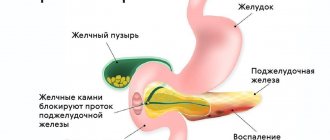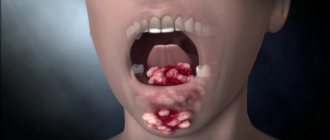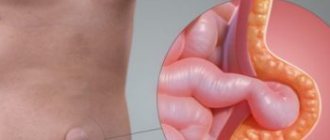Flatulence is a common condition in adults. According to statistics, at least 40% of people who consult a gastroenterologist complain of constant increased gas formation, and up to 100% of people have experienced it at least once in their lives. In the absence of diseases of the gastrointestinal tract, flatulence in adults does not pose a serious threat to health, but it significantly reduces the quality of life and causes a lot of inconvenience.
There are three sources of gas in the intestines:
- air swallowed during eating, talking, smoking;
- formation of gases in the intestinal lumen, including production by intestinal bacteria;
- gases entering the intestines from the blood.
Normally, about 200 ml of gas is present in the gastrointestinal tract at a time. During the day, more than 20 liters are formed, and most of the gases are destroyed and absorbed through the intestinal walls. The exceptions are nitrogen and hydrogen sulfide - they are removed only through the rectum. With flatulence, the volume of gas becomes larger, which causes serious discomfort to the person.
Causes of increased gas formation
Excessive gas formation can be due to a variety of reasons. One of them is the imperfection of the enzyme system or disruption of its function, which is more typical for children in the first days of life. Researchers Yazenok and Zhelnova (Yazenok N.S., Zhelnova T.I., Bondarenko N.V., Novokshenova T.P., Kirsanova A.I., 2003, p. 16). In this case, the following causes of flatulence are distinguished:
- unbalanced diet;
- diseases of the upper gastrointestinal tract: duodenitis, gastritis;
- diseases of the liver and gall bladder: hepatitis of any origin, cholecystitis, etc.
Other mechanisms for the development of the disease include imbalances in the microflora of the colon. With them, carbohydrates and proteins that come with food are not completely absorbed by the mucous membrane. Normally, dietary fiber from fruits and vegetables, especially legumes and coarse-fiber fruits, is broken down by intestinal bacteria. The result of their vital activity is the formation of a large volume of gases. A significant portion of gases is absorbed by aerobic intestinal bacteria. And with dysbacteriosis, the balance between bacteria producing and consuming gases is disrupted. However, it is important to remember that even in the absence of microflora imbalance, a special diet can cause the formation and release of large amounts of gases. A diet based on foods rich in cellulose and beans can cause flatulence. Other products that increase gas formation include soda, lamb meat, as well as products in which fermentation and fermentation processes are already occurring, for example, kvass.
Another mechanism for the development of flatulence is intestinal distension due to paresis. This is due to abdominal surgeries performed. In this case, the cause of flatulence in adults is the very fact of the intervention. After it, intestinal motility slows down, and this leads to fermentation and putrefactive processes. The condition is accompanied by spasmodic pain because gases accumulate in the intestinal lumen.
A common cause of increased gas formation is emotional stress, nervous disorders and shocks. The mechanism of development of this syndrome is explained by spasm of smooth muscles, including the intestines, and a slowdown in peristalsis.
Bloating and gas formation: modern treatment options
Bloating is a very common and very unpleasant symptom that makes a person suffer even more than from abdominal pain. Bloating is a gas-related symptom. The sensation of excess gas in the gastrointestinal tract (GIT) is most often associated with increased tension in the wall of the hollow organ and can be a consequence of both actual excess formation (and/or impaired removal of gases from the GIT) and the result of high visceral sensitivity.
The subjective feeling of bloating (part of the symptom complex of flatulence syndrome) is usually accompanied by painful objective manifestations: an increase in abdominal circumference, loud rumbling (borborygms), sudden release of gases through the mouth (belching), accompanied by specific sound manifestations, uncontrolled release of foul-smelling gases (flatulence). All these symptoms cause psychological discomfort, feelings of shame and guilt, and negatively affect mental status, leading to restlessness, anxiety, depression, and phobic moods. If bloating and associated problems become persistent, a person’s normal lifestyle, family and social relationships are disrupted, the quality of life decreases, and the range of social and behavioral activity is narrowed. As a rule, gas-associated symptoms worsen during periods of psycho-emotional stress, with changes in climatic and time zones, and changes in nutritional patterns.
The symptom of bloating has no age limit [1] and is one of the most common, observed in more than 85% of gastroenterological patients [2]. Among patients with a functional gastrointestinal disorder (FGID), abdominal bloating is observed in approximately 24–97% of patients and, in addition, very often occurs in patients with gastroesophageal reflux disease (GERD), diseases of the pancreas and gallbladder, premenstrual syndrome, and impaired intestinal motility . Patients suffering from irritable bowel syndrome (IBS) with bloating are more likely to visit the doctor, and the impact of their disease on quality of life is more pronounced than the impact of IBS without bloating [3].
Abdominal bloating occasionally occurs in almost all people and, as a rule, is clearly related to dietary habits, i.e., consumption of foods with a high gas-forming potential. Thus, according to the results of a population study conducted in our country among a practically healthy contingent of respondents, it was found that over the last week signs of flatulence were noted by 28%, over the last month - 44%, over the last year - 62% of respondents [4].
The prevalence of functional bloating in adults in the United States ranges from 6% to 31%, with an average pooled prevalence estimate of 15.9%, and is more common in women (19.2%) than in men (10.5%) [5].
The high variability in the prevalence of bloating is associated, firstly, with different perceptions of the term. Patients and doctors interpret the content of this concept differently (as a variant of a subjective feeling of fullness and bloating of the abdomen; the appearance of hardness and tension in the anterior abdominal wall; excessive formation and discharge of gases; and as an objective increase in abdominal girth, and, finally, as a manifestation of any other dyspeptic complaints). Secondly, some patients suffering from bloating do not seek medical help for a long time, in particular, because of the moral and ethical complexes that accompany the excessive formation of gases in the intestines; on the contrary, other people ignore these symptoms, believing they are of little significance for overall health. All this not only complicates the epidemiological assessment of the syndrome, but also does not allow us to formulate diagnostic criteria convenient for clinical practice and objective assessment of the effectiveness of drug therapy.
In the new edition of the Rome IV criteria, functional abdominal bloating/distension still forms part of a large group of functional gastrointestinal disorders of the gastrointestinal tract-central nervous system interaction (Table 1) and is considered as a diagnosis per se in patients who do not meet the Rome criteria within the framework of other gastrointestinal tract disorders, although the possibility of mild abdominal pain and/or minimal bowel movements is acceptable.
Experts of the Rome IV criteria propose to combine functional abdominal bloating and distension into one concept, although they emphasize that these symptoms can be observed in isolation, do not correlate with each other and have different pathophysiological mechanisms of development [6].
Functional bloating differs from other cases of abdominal distension in its circadian rhythm: in typical cases it increases after meals (usually after eating certain so-called problem foods) and during the day and decreases or disappears at night. Problematic foods include sugars, more specifically oligo- and polysaccharides, which pass unchanged into the large intestine, where they are fermented by fermenting and proteolytic microorganisms. This process is accompanied by the release of gas. Excessive perception of intestinal gases forms the symptoms of the disease [7].
Key points in the conceptual understanding of the pathogenesis of functional abdominal bloating/distension include visceral hypersensitivity, gas formation in the colon, and changes in gastrointestinal motility. The mechanisms associated with visceral hypersensitivity are fueled by alert anticipation of perceived unpleasant events. In the dysregulation of the brain-gut axis, genetic predisposition, environmental factors, chronic stress, and disorders of the intestinal microflora play a role [8].
Currently, the main causes of functional bloating are considered: visceral hypersensitivity, colonic fermentation, excessive bacterial growth in the small intestine and changes in the metabolic potential of the colon microbiota, disruption of intestinal transit and rectal gas evacuation [9].
The study of the pathophysiological mechanisms of development of the symptom of functional abdominal distension, thanks to innovations in diagnostics, including abdominal induction plethysmography (which makes it possible to measure abdominal distension), allows us to consider an abnormal viscerosomatic reflex involving the diaphragm and muscles of the anterior abdominal wall as the main predictor of the formation of this symptom. The mechanism of this reflex is not yet known. Studies have shown that colonic fermentation, decreased rectal sensation, and impaired intestinal transit may contribute to abdominal distension in some patients [9, 10].
The diagnosis of functional swelling must be established with indispensable reliance on 3 key positions: 1) anamnesis and clinical picture; 2) a thorough physical examination; 3) exclusion of anxiety symptoms with the minimum required set of laboratory and instrumental tests [11].
Despite the significant prevalence of functional bloating/distension of the abdomen, there are no clearly developed treatment algorithms for this pathology. The list of methods for effective treatment of bloating and distension is very limited (Table 2).
Some dietary changes, such as avoiding carbonated drinks and foods that tend to cause gas, can help reduce the symptoms associated with bloating. The exclusion from the diet of poorly digestible and assimilated short-chain carbohydrates (fermentable carbohydrates; oligo-, di- and monosaccharides; polyols) also has a positive effect, that is, bloating decreases when following a diet that excludes the entry into the colon of intensively fermentable substrates, such as wheat products; fruits rich in fructose (for example, apples, pears); vegetables containing fructans (onions, asparagus, etc.); products containing raffinose (for example, legumes, beets), sorbitol (sugar-free chewing gum) [3].
Helps prevent bloating caused by eating problematic foods by taking alpha-galactosidase (Orlix, dietary supplement) with meals. Alpha-galactosidase provides enzymatic activity missing in the human body, breaking down oligosaccharides into simpler, easily digestible forms. As a result of the use of Orlix, the amount of fermentable substrates entering the colon is reduced and the overproduction of gas associated with nutrition is prevented [12, 13].
In addition, some improvement can be expected from moderate physical activity, which facilitates bowel movements and gas transport.
Reduces the severity of bloating and abdominal distension by taking prokinetics. Prokinetics, accelerating intestinal transit, promote the movement of gas through the intestine and its removal to the outside [14]. However, prokinetics (lubiprostone and linaclotide), recommended by experts of the Rome IV criteria, for the treatment of bloating are not registered in our country. Among the drugs available on the Russian pharmaceutical market, trimebutine (Trimedat) is a universal regulator of gastrointestinal motility. Trimebutine is an opiate receptor agonist, its modulating effect on gastrointestinal motility and analgesic effect are associated with a nonspecific effect on all classes of peripheral opiate receptors: μ, κ and δ. Trimebutine stimulates the evacuation function of the stomach, normalizes intestinal motility and gas transit, reduces visceral sensitivity, helps relieve the feeling of bloating and discomfort, and has a beneficial effect in both hypokinetic and hyperkinetic forms of disorders of motor activity of the gastrointestinal tract. In the treatment of flatulence, a course prescription of the drug Trimedat 200 mg three times a day 30 minutes before meals for 30 days or more is indicated [15].
Currently, the study of the role of disturbances in the intestinal bacterial flora in the occurrence of gastrointestinal tract is ongoing. Thus, it was found that there are some species differences in the microbiome of healthy people and patients with bloating. This has prompted numerous clinical studies to study the effectiveness of antibiotics, probiotics and prebiotics for flatulence. Two probiotics have been shown to reduce visceral sensitivity in animal models: Bifidobacterium infantis and Lactobacterium acidophilus.
In the treatment of disorders associated with high levels of gas in the gastrointestinal tract, antiflatulents, or defoamers, are traditionally used. A drug that reduces foaming in the intestinal lumen is simethicone, which is a high-molecular silicon-based polymer - dimethylsiloxane with the addition of silicon dioxide. According to its mechanism of action, simethicone is a surfactant that reduces the surface tension of gas bubbles in chyme and mucus in the intestinal lumen, leading to their rupture. In this case, a process of coalescence occurs - the fusion of gas bubbles and the destruction of foam, as a result of which free gas is able to be absorbed through the intestinal mucosa or evacuated along with the intestinal contents. The dose is selected individually depending on the severity of symptoms. The main use of defoamers in clinical practice is the symptomatic treatment of various gastrointestinal diseases accompanied by excessive gas formation [2].
It is known that antidepressants modulate visceral sensitivity, they are often recommended for patients with gastrointestinal tract, but to date, based on the results of clinical studies, impressions of their effectiveness have not been definitively determined [3].
As a result, we have to admit that bloating and distension of the abdomen are difficult to treat. As soon as the connection of these symptoms with organic diseases is excluded, it is reasonable to place emphasis on the functional nature of these conditions, and in treatment it is advisable to pay attention primarily to the implementation of a diet and taking the biologically active food supplement Orlix.
The active component of Orlix is a natural enzyme - alpha-galactosidase (producer - the bacterium Aspergillus niger). 1 tablet contains 5 mg (corresponds to 150 units) of alpha-galactosidase. Does not contain GMOs, lactose, milk proteins, dyes, flavors and preservatives.
In order to study the effectiveness and tolerability of Orlix in patients with functional bloating/distension of the abdomen, an open, non-randomized, placebo-uncontrolled, multicenter study was conducted in Moscow city clinics.
Objectives of the clinical trial:
- To study the possibility of correction of gas-associated symptoms after ingestion of problematic foods in patients with functional bloating/distension of the abdomen when consuming Orlix with meals.
- Assessment of the tolerability of Orlix and its impact on quality of life.
Problematic foods:
- all types of beans (white, red, brown and their variants);
- lentils - all types;
- all types of cabbage (white, red);
- kohlrabi and Brussels sprouts;
- cauliflower and broccoli;
- salads of all kinds;
- onion garlic;
- carrots, parsley;
- flour and flour products (especially from wholemeal flour);
- pistachios and sesame;
- soybeans and soy products (soy milk, tofu).
Study design
The study involved 55 patients with complaints of flatulence (bloating, belching, increased passage of gas, a feeling of fullness in the abdomen, increased abdominal circumference) associated exclusively with the consumption of problematic foods, after excluding all other possible causes of gas-associated symptoms. Patients were examined according to a unified plan (general clinical analysis of blood, urine, stool, biochemical blood test, esogastroduodenoscopy, colonofibroscopy, ultrasound examination of the abdominal organs). At the end of the study, all patients underwent a repeat examination of general clinical and biochemical blood tests.
The average duration of complaints in patients included in the study was 3.5 years. The male to female ratio is 20:35. Average age 38 ± 5.5 years.
A prerequisite for patient inclusion in the study was the refusal to use any antiflatulent drugs and the continuation of taking problematic (gas-forming) products in the usual volume.
All patients included in the study took the dietary supplement Orlix with the first portion of problem food in a dose of 2–4 tablets for 2 months.
The effectiveness of Orlix was assessed based on the patient’s subjective assessment of the manifestations of flatulence at the beginning of the study, and then during the 1st and 2nd control studies (after one and two months of treatment, respectively) according to the severity of symptoms: 1st degree - all gases associated symptoms are completely eliminated, 2nd degree - mild symptoms of flatulence that do not bother the patient in everyday life, 3rd degree - improvement is observed, but in a mild form gas-associated symptoms persist, 4th degree - very little or no improvement.
As part of the overall assessment of the effectiveness of Orlix after 2 months of its use, based on a subjective assessment of the severity of symptoms of flatulence, patients were divided into 4 groups: 1st group - excellent - improvement of symptoms by 100% (corresponding to the assessment of the 1st degree), Group 2 - very good - improvement of symptoms by 50-80% (corresponding to a grade 2 assessment), Group 3 - moderate - improvement of symptoms by 30-50% (corresponding to a grade 3 assessment), 4th group - no changes - 0–30% (corresponds to a grade 4 assessment). All study statistics are based on patients' subjective assessment of gas-related symptoms after consuming problematic foods.
The effectiveness and safety of Orlix was also analyzed based on data from the SF-36 questionnaire to assess quality of life.
A study of anthropometric parameters (body weight and abdominal circumference) was carried out before the start of treatment and upon its completion.
Research results
Subjectively, already at the first control examination, 28 (50.9%) patients noted a complete elimination of the development of symptoms of flatulence after eating problematic foods while taking Orlix with meals; after 2 months of treatment, the number of patients with excellent effectiveness of Orlix increased to 32 (58.2 %).
Mild symptoms of flatulence persisted and did not bother the patient in everyday life in 19 (34.6%) patients at the end of the first month of treatment; subsequently, two of them noted the almost complete disappearance of gas-associated symptoms (with an increase in the single dose of Orlix to 3 tablets).
It is noteworthy that the number of patients who reported that, despite taking Orlix, they still had mild gas-associated symptoms, did not depend on the duration of treatment: 6 (10.9%) people at the 1st control and 5 ( 9.1%) at the end of observation. In one patient from this group, complete relief of abdominal bloating occurred when the single dose of Orlix was increased to 3 tablets.
Only 2 (3.6%) patients noted no improvement during the first month of treatment. One patient had the Orlix dose increased to 3 tablets per dose when consuming problematic foods, and against this background he noted a significant improvement. In another patient, increasing the dose of Orlix to 4 tablets per dose resulted in only minor relief of symptoms.
Thus, subjective improvement, despite continuing to take the usual amounts of problem foods, when using Orlix with meals was detected in 98.2% of patients (Table 3), and all of them noted the rapid onset of action of the biologically active food supplement when following the regimen taking Orlix with the first portions of food.
The overall assessment of the effect of Orlix after 2 months of its use, based on the patient’s subjective assessment of the severity of symptoms of flatulence, is presented in table. 4. An excellent effect was registered in 32 (58.2%) patients, a very good effect in 17 (30.9%), moderate improvement in symptoms was noted by 5 (9.1%) people. Only one patient in the study reported very little improvement in flatulence symptoms.
At the same time, not only subjective improvement was noted in patients; when studying the dynamics of anthropometric parameters, a tendency to a decrease in abdominal circumference was revealed, which was more pronounced in women while maintaining a constant body weight (Table 5).
When analyzing changes in the quality of life according to the nosologically nonspecific questionnaire SF-36 during treatment with Orlix, positive dynamics were also revealed: there was a significant improvement in the quality of life in almost all indicators of both physical and mental functioning. The mean physical functioning (PF) score increased from 85.1 ± 6.4 to 92.2 ± 2.1 points (p < 0.05); role physical functioning (RP) - from 51.3 ± 5.1 to 85.2 ± 2.3 points (p < 0.05); the general health (GH) score increased from 48.9 ± 8.4 to 61.21 ± 2.1 points (p < 0.05). Indicators of the psychological component of health changed as follows: vitality (VT): 54.6 ± 6.3 and 78.2 ± 4.9 points (p < 0.05); social functioning (SF) - 47.6 ± 11.2 and 68.8 ± 5.3 points (p < 0.05); role emotional functioning (RE) - 58.8 ± 8.4 and 70.2 ± 3.1 points (p < 0.05).
As part of the subjective assessment, the dosage of Orlix was statistically evaluated. At the beginning of the clinical study, a dosage of 2 tablets was prescribed to 32 (58.2%) patients, 3 tablets to 23 (41.8%) patients, a dosage of 4 tablets was not prescribed. During the first control, in 6 patients with the 3rd degree of severity of gas-associated symptoms, the dosage of Orlix was increased to 3 tablets and in 1 patient who did not notice an improvement in symptoms, the dose of the drug was increased to 4 tablets. However, increasing the dosage did not significantly affect the subjective feeling of the severity of flatulence symptoms. Thus, it was found that the dosage of Orlix is less correlated with the severity of gas-associated symptoms, and more dependent on the amount of food eaten; usually it is enough to take 2-3 tablets during a normal lunch (Table 6).
The dynamics of the main parameters of general clinical and biochemical blood tests (ALT, bilirubin, glucose) in the direction of deterioration were not observed (Table 7).
All patients noted good tolerability while taking Orlix; no adverse reactions were recorded.
Discussion
The study included patients with functional bloating/distension. All of them noted the connection between the occurrence of gas-associated symptoms and the consumption of problematic foods, such as beans, lentils, all types of cabbage, as well as kohlrabi, broccoli, salads of all types, onions, garlic, carrots, parsley, whole wheat flour products, pistachios and sesame seeds, soybeans and soy products. These products are united by a high content of oligosaccharides (melibiose, raffinose, stachyose, verbascose), formed by galactose and fructose, in various ratios (Table 8), since soy contains a lot of them, they are also called “soy oligosaccharides”.
Galactose (from the Greek root γaλακτ-, “milk”) is one of the simple sugars, a monosaccharide from the hexose group. D-galactose is widespread in nature, it is part of oligosaccharides (melibiose, raffinose, stachyose), some glycosides, plant and bacterial polysaccharides (gums, mucus, galactans, pectins, hemicelluloses), in animals and humans - in the composition of lactose, group-specific polysaccharides, cerebrosides, keratosulfate, etc. Fructose (fruit sugar), C6H12O6 - monosaccharide, isomer of glucose. In its free form, fructose is present in almost all sweet fruits, and also makes up up to 80% of honey; as a monosaccharide unit it is part of sucrose and lactulose.
Soy oligosaccharides are widely used in the food industry (soft drinks, candies, cakes, industrially prepared wheat products, dairy products, infant milk powder, etc.), and are included in many pharmaceuticals.
But human digestive enzymes are not able to break down the chemical bond between two galactose molecules, so these oligosucroses are not absorbed in the small intestine, but are hydrolyzed by enzymes of colon microbes (which have a set of enzymes that utilize soy sugars) with the formation of organic acids and large amounts of gases: H2, CH4 , CO2 (hence the name of products containing such oligosaccharides - gas-forming, or problematic).
As a result of research, it was possible to isolate a unique bacterial enzyme - α-galactosidase, which hydrolyzes galactosidase compounds, breaking down oligosaccharides into simple carbohydrates without the formation of gases. Such enzymes are found in the bacteria Bacteroides fragilis, Bacteroides thetaiotaomicron and Streptomyces avermitilis.
Alpha-galactosidases (syn. melibiases) have “exoactivity”, i.e. they cleave off the terminal non-reducing residues of alpha-D-galactose from the oligosaccharide molecule, hydrolyzing complex sugars to monosaccharides: glucose and galactose, which are absorbed by the cells of the intestinal mucosa and are used in body as a source of energy.
The use of the enzyme alpha-galactosidase in nutrition provides enzymatic activity absent in the human body, limiting the entry of oligosaccharides into the large intestine in an undigested form, where they undergo anaerobic bacterial hydrolysis with the formation of gases.
When adding this enzyme in the form of a dietary supplement to Orlix food, we found its effect in a group of 55 people to be excellent in 58.2%, and very good in 30.9%. Thus, patient-reported improvement after taking Orlix occurred in the vast majority of patients (89.1%).
When analyzing changes in quality of life according to the SF-36 questionnaire during monotherapy with Orlix, a significant improvement in quality of life was revealed in terms of both physical and psychological functioning.
All patients while taking Orlix noted that it was well tolerated.
Conclusion
In patients with functional bloating, taking the dietary supplement Orlix (active substance alpha-galactosidase) provides high effectiveness in relieving gas-associated symptoms and improves quality of life. Recommended dosage of Orlix: 2-3 tablets with meals with the first portions of food when consuming gas-forming foods. It is important to note that the onset of action of Orlix is immediate; flatulence does not occur when eating problematic foods. The dosage depends on the volume of problem foods eaten; 2-3 tablets are usually sufficient for average amounts of food. In the future, the patient can determine the optimal dose for himself.
Orlix is safe to use and can be recommended for healthy people who consume gas-producing products.
Reducing gas production in the intestines may represent an effective therapeutic strategy to prevent the development and/or exacerbation of gas-related symptoms in any gastrointestinal disease (functional or organic) when their cause is at least in part due to hyperproduction of gas.
Literature
- Belmer S.V., Gasilina T.V., Khavkin A.I. et al. Functional disorders of the digestive organs in children. M.: RGMU, 2005. 36 p.
- Butorova L.I., Kolomoets A.N., Tarasova E.S. Excessive gas formation syndrome in the intestines: clinical significance and principles of therapy // Difficult Patient. 2005.
- Functional disorders of the gastrointestinal tract. A practical approach based on clinical experience / Ed. B. E. Lacey, M. D. Crowell, D. C. DiBaiza. Per. from English edited by S. V. Demicheva. M.: GEOTAR-Media, 2021. 352 p.
- Flatulence syndrome in therapeutic practice: optimization of treatment approaches: educational manual / Ed. Yu. P. Uspensky. St. Petersburg: InformMed, 2010. 63 p.
- Sandler RS, Stewart WF, Liberman JN, Ricci JA, Zorich NL Abdominal pain, bloating, and diarrhea in the United States: prevalence and impact // Dig DisSci. 2000; 45:1166–1171.
- Drossman DA Functional gastrointestinal disorders: history, pathophysiology, clinical features and Rome IV // Gastroenterology. 2016; 150: 1262–1279.
- Agrawal A., Houghton LA, Lea R. et al. Bloating and distension in irritable bowel syndrome: The role of visceral sensation // Gastroenterology. 2008. Vol. 134. P. 1882–1889.
- Camilleri M., Lasch K., Zhou W. Irritable bowel syndrome: Methods, mechanisms, and pathophysiology. The confluence of increased permeability, inflammation, and pain in irritable bowel syndrome // Am J Physiol. Gastrointest. Liver Physiol. 2012, 303: 775–785.
- Lewis MJ, Reilly B, Houghton LA et al. Ambulatory abdominal inductance plethysmography: towards objective assessment of abdominal distension in irritable bowel syndrome // Gut. 2001; 48: 216–220.
- Houghton LA, Lea R, Agrawal A et al. Relationship of abdominal bloating to distention in irritable bowel syndrome and effect of bowel habit // Gastroenterology. 2006; 131:1003–1010.
- Pimanov S.I., Silivonchik N.N. Rome IV recommendations for the diagnosis and treatment of functional gastroenterological disorders. A manual for doctors. M., 2021. 160 p.
- Orlix®. Instructions for use.
- Expert opinion of the Federal Budgetary Institution of Health and Safety of Rospotrebnadzor No. 10–2 FC/2098 dated May 28, 2015.
- Cadarella M., Serra J., Azpinoz F. et al. Prokinetic effect in patients with intestinal gas retention // Gastroenterology. 2002. Vol. 122. P. 1748–1755.
- Ivashkin V. T., Poluektova E. A., Reykhat D. V. et al. Efficacy of the most commonly prescribed groups of drugs in patients with functional disorders of the gastrointestinal tract - functional dyspepsia syndrome and irritable bowel syndrome (Results of an observational study) // Ross. Journal of gastroenterology, hepatology, coloproctology. 2016; 26 (4): 15–23.
- Posserud I., Stotser PO, Bjornsson ES et al. Small intestinal bacterial overgrowth in patients with IBS // Gut. 2007. Vol. 56. P. 802–808.
L. I. Butorova*, 1, Candidate of Medical Sciences N. G. Kadnikova** M. A. Osadchuk*, Doctor of Medical Sciences, Professor T. E. Plavnik*** G. M. Tokmulina*, Candidate of Medical Sciences
* Federal State Autonomous Educational Institution of Higher Education First Moscow State Medical University named after. I. M. Sechenova Ministry of Health of the Russian Federation, Moscow ** TsKBVL FMBA “Goluboe”, Goluboe *** State Budgetary Institution of Public Health No. 195 DZM, Moscow
1 Contact information
Bloating and gas formation: modern treatment options / L. I. Butorova, N. G. Kadnikova, M. A. Osadchuk, T. E. Plavnik, G. M. Tokmulina
For citation: Attending physician No. 2/2018; Page numbers in the issue: 61-66 Tags: excess gas formation, enzymatic preparation
Types of flatulence
Intestinal flatulence can be of several types depending on the causes:
- nutritional – associated with dietary disorders;
- digestive - appears when abdominal digestion is disrupted (with cholelithiasis, gastritis, inflammation of the pancreas, etc.);
- dysbiotic - formed as a result of excessive bacterial growth of the small intestine and/or imbalance of the microflora of the large intestine;
- mechanical - occurs due to a mechanical obstacle to the evacuation of feces and gases (with narrowing of the intestinal lumen, tumor, adhesive disease);
- dynamic - is the result of disturbances in intestinal motor activity (with dyskinesia, acute infection, poisoning);
- circulatory - develops when the blood supply to tissues is disrupted (for example, with ischemic colitis);
- psychogenic - appears in connection with a psycho-emotional state, neuropsychic disorder;
- high altitude - occurs when you rise to a height, gases expand, and pressure in the intestines increases.
Thus, the causes of the disorder can be either minor dietary disturbances or flights, or serious intestinal diseases. A doctor will help you figure this out.
Symptoms of flatulence
Flatulence may be accompanied by pain in various parts of the abdomen, bloating, a feeling of fullness, and a false urge to defecate. The severity of the pain varies depending on the volume of gases, the degree of stretching of the intestinal walls due to the accumulation of gases. Doctors Pakhomovskaya and Venediktova in their work point out that “the intensity of abdominal pain depends not only on the amount of accumulated gases, but also on the level of the threshold of visceral pain sensitivity” (Pakhomovskaya N.L., Venediktova M.M., 2021, p. 34). This means that the reaction can be individual. Much depends on whether a person had colic in infancy. It is known that when they are present, functional pain occurs more often in adulthood.
Flatulence in adults may be accompanied by other manifestations:
- nausea;
- belching;
- bowel disorders;
- decreased appetite;
- irritability, etc.
Doctors conventionally divide flatulence into two variants of manifestation. In the first case, the main symptom is an increase in abdominal volume, that is, bloating. In this case, normal passage of gases does not occur due to spasm of the colon.
In the second option, the passage of gas is violent and frequent, and the pain is not expressed. Patients complain of a characteristic rumbling in the stomach, a feeling of “rolling” in the intestines.
Pain can occur in one area or throughout the entire abdomen. The local nature of the discomfort is associated with the accumulation of gases in a certain part of the intestine, usually in the area of the cecum. They are not necessarily associated with episodes of eating or exercise. Extraintestinal symptoms also rarely occur: burning in the chest, tachycardia, weakness, sleep disturbances.
Meteospasmil
Another anti-bloating drug with a complex effect, it contains simethicone and alverine citrate. Simethicone acts on intestinal gas bubbles, and alverine citrate works as an antispasmodic, relaxing the intestinal muscles, reducing its tone, and reducing pain. In this case, intestinal hypotension does not develop. These two active ingredients of Meteospasmil help gases to escape naturally. Meteospasmil is prescribed for flatulence and bloating, nausea, belching, and constipation. The drug is also suitable for preparing the patient for various examinations (ultrasound, endoscopy of the stomach or intestines). Adults take one capsule three times daily before meals. The course of treatment for flatulence is one week. Meteospasmil is prescribed to patients with intestinal hypertonicity (usually they suffer from spastic constipation). Allergic reactions to the drug are very rare. Meteospasmil is not indicated for pregnant women and those who are breastfeeding.
Meteospasmil
Maioli Spindler Laboratories, France
Functional gastrointestinal disorders, manifested by abdominal pain, increased gas formation, belching, nausea, constipation, diarrhea or their alternation;
— preparation for x-ray, ultrasound or instrumental examination of the abdominal organs. from 362
5.0 1 review
731
- Like
- Write a review
Features of nutrition during flatulence
The first step in the treatment of intestinal flatulence for any reason is diet correction. It is important to completely avoid foods that stimulate increased gas formation:
- legumes: beans and peas, lentils;
- products rich in cellulose, coarse fiber, essential oils: sorrel, garlic, onions, radishes, gooseberries, dates, etc.;
- products that cause fermentation processes: kvass, black bread, grapes (including raisins);
- alcohol and soda;
- whole milk.
You should also stop chewing gum and smoking or limit the number of cigarettes you smoke.
There are dishes that can be consumed, but in smaller quantities. So, Gureev o (Gureev A.N., 2010, p. 306).
The diet should be based on fermented milk products, buckwheat and millet porridge, low-fat varieties of fish, meat and poultry. It is better to steam or boil food. It is important to choose bread made from wholemeal wheat flour. Vegetables and fruits should be consumed baked or boiled.
Gastrointestinal motility stimulants
A New Year's diet, replete with fatty, spicy and salty foods, can increase the production of the neuropeptide hormone cholecystokinin [4], which inhibits the motor-evacuation function of the stomach, which is manifested by a feeling of fullness in the stomach, epigastric pain, nausea, and in severe cases, vomiting. To relieve these manifestations, motor stimulants, or prokinetics, are used.
Metoclopramide, known to several generations of doctors and patients, has prokinetic activity.
As an antagonist of dopamine and serotonin receptors, metoclopramide stimulates the motility of the upper gastrointestinal tract, improves the amplitude of gastric contractions, relaxes the pyloric sphincter and duodenal bulb. In addition, metoclopramide has an antiemetic effect, which is due to the blockade of central and peripheral D2-dopamine receptors. However, along with proven effectiveness, the widespread use of metoclopramide is limited by frequent side effects (almost 30% of cases), including headache, drowsiness, hormonal disorders and other adverse events [5].
A modern and well-tolerated alternative to metoclopramide is the highly selective peripheral dopamine D2 receptor blocker domperidone.
By inhibiting dopamine receptors, the drug increases the release of acetylcholine, which provides an antiemetic effect. In addition, domperidone has a gastrokinetic effect, increases the duration of antral and duodenal contractions, accelerates gastric emptying, and also increases the pressure of the sphincter of the lower esophagus. Maximum absorption of the drug occurs when it is used before meals, that is, in our case, before a gala dinner. Domperidone belongs to the over-the-counter group of drugs and is used to treat adults and children, including newborns.
Along with domperidone, itopride is used as a stimulant of gastrointestinal motility.
It has a dual mechanism of action: the drug interacts with D2-dopamine receptors and also inhibits acetylcholinesterase, which leads to activation of propulsive gastric motility. Itopride accelerates the transit of food through the stomach and ensures faster emptying. Unlike domperidone drugs, itopride is available only with a doctor's prescription.
Lifestyle change
In the treatment of flatulence, daily routine and healthy habits are important. It is necessary to increase the frequency of meals, up to 5-6 times a day. Breakfast should consist of cereals.
It is important that each meal is calm; there is no need to talk during lunch. Try to chew your food thoroughly and take your time—allow enough time for lunch and snacks during the day. You should also not eat food while lying down. It is better to avoid drinking drinks through a straw or sucking on caramel.
A sufficient amount of water is important in the fight against stool disorders and the formation of large amounts of gas. Researcher Shulpekova in her scientific work points out that “sufficient fluid intake is up to 2–2.5 l/day. helps soften feces and diffusion of gases into the bloodstream” (Shulpekova Yu. O., 2013, p. 57).
You can help yourself with a food diary. Record the foods you eat and your feelings in it. This way you can understand which foods make your symptoms worse.
Drug treatment
Treatment of flatulence in adults may include a number of medications:
- enzyme preparations;
- choleretic drugs;
- probiotics and prebiotics;
- antispasmodics and prokinetics, etc.
Enzyme replacement therapy can help reduce symptoms if they are caused by enzyme deficiency or pancreatic disease. Choleretic agents increase the volume of bile in the intestine, which promotes normal motility in diseases of the hepatobiliary system.
Restoring the normal balance of microflora is an important factor in the treatment and prevention of flatulence. The doctor may prescribe prebiotics, probiotics or synbiotics containing lactobacilli. They have been proven to suppress excess gas formation.
Intestinal motor disorders can be eliminated with the help of prokinetics or antispasmodics. Such prescriptions require careful examination; drugs have certain restrictions and are prescribed according to indications.
Treatment of flatulence that develops as a result of poor nutrition may involve only symptomatic therapy. Adsorbents are able to bind gases in the intestines and reduce their volume, relieving unpleasant symptoms. It is important to understand that some sorbents can cause stool retention, so you should be careful when choosing a drug.
"Fitomucil Sorbent Forte" is a drug that can be recommended for flatulence. This is a natural sorbent, the action of which is complemented by a complex of probiotics in the composition. The product works due to dietary fiber - the shell of plantain seeds: it absorbs toxins, excess liquid and gases, and helps reduce gas formation in the intestines. Inulin in Fitomucil Sorbent has a probiotic effect and stimulates the growth of beneficial microflora. A complex of living probiotic bacteria has a beneficial effect on digestion. One of the indications for the use of the drug is post-infectious digestive disorders in the form of diarrhea, flatulence, and unstable stool.
Simethicone with fennel from Evalar
The drug perfectly reduces the formation of gases, so it is prescribed for bloating and colic. The active ingredients of the capsules are simethicone and fennel essential oil. Fennel eliminates the urge to vomit and is a natural antispasmodic. Patients note in reviews that “Simethicone with fennel” improves digestion and has no “side effects” even with long-term use. An important advantage is that during treatment with this drug the absorption of food is not impaired and the volume of gastric juice does not change. Adults with flatulence are prescribed one capsule three to five times a day. “Simethicone with fennel” is inexpensive, it has a convenient release form, and it effectively relieves increased gas formation. Contraindications: pregnancy and breastfeeding.
Simethicone with fennel
Evalar, Russia
Dietary supplement Simethicone with fennel helps reduce gas formation and relieve bloating and functional colic.
from 142
5.0 8 reviews
1002
- Like
- Write a review
Traditional methods of treating bloating
Photos from open sources











